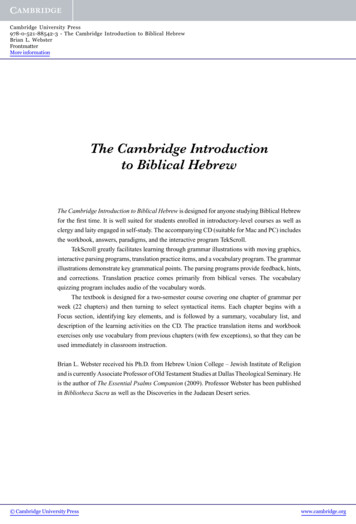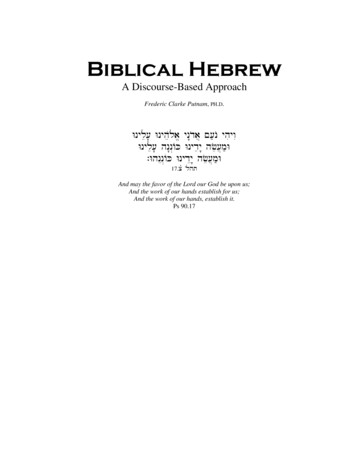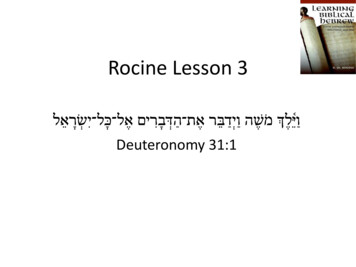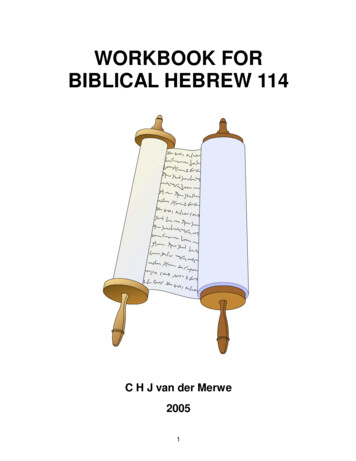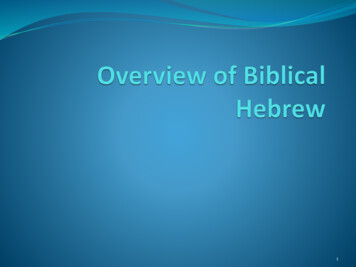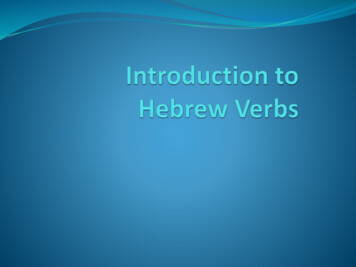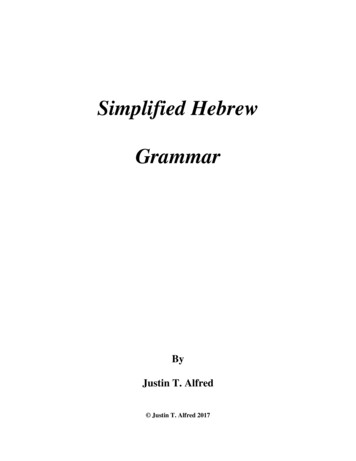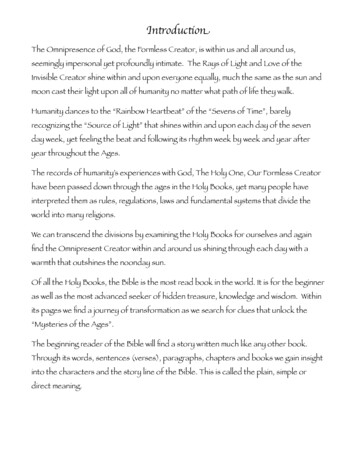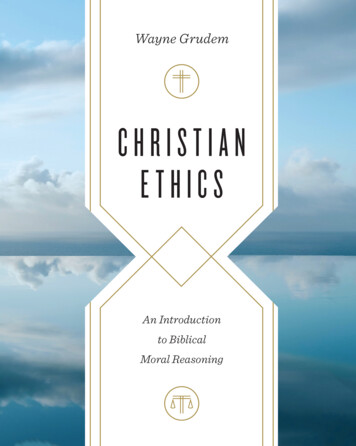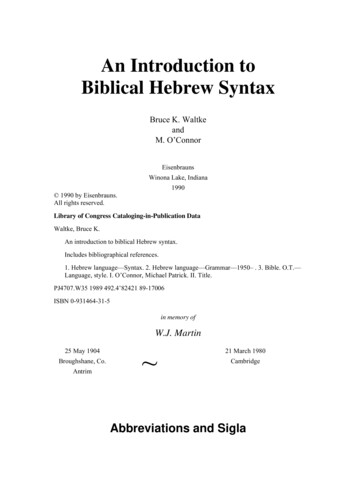
Transcription
An Introduction toBiblical Hebrew SyntaxBruce K. WaltkeandM. O’ConnorEisenbraunsWinona Lake, Indiana1990 1990 by Eisenbrauns.All rights reserved.Library of Congress Cataloging-in-Publication DataWaltke, Bruce K.An introduction to biblical Hebrew syntax.Includes bibliographical references.1. Hebrew language—Syntax. 2. Hebrew language—Grammar—1950– . 3. Bible. O.T.—Language, style. I. O’Connor, Michael Patrick. II. Title.PJ4707.W35 1989 492.4’82421 89-17006ISBN 0-931464-31-5in memory ofW.J. Martin25 May 1904Broughshane, Co.Antrim 21 March 1980CambridgeAbbreviations and Sigla
Grammatical Termsabs.absolutetwicebisCconsonantCconstruct termc.commoncoll.collectivecstr.constructENWSEarly Northwest Semiticf(em).Focfemininefocus markerGgenitive termimpfv.imperfectiveinf. abs.infinitive absoluteinf. cstr.infinitive perfectpfv.perfectivepl.pluralpleopleonastic verb*unattested form** impossible formapproximately equal to
Versions and TranslationsAVAuthorized Version (1611)LXXMTSeptaugintMasoretic TextNABNew American Bible (1970)NIVNew International Version (1973)NJPSNew Jewish Publication Society Version (1982)RSVRevised Standard Version (1952)SamSamaritan PentateuchBibliographyBLHans Bauer and Pontus Leander. 1922. Historische Grammatik der hebräischenSprache des Alten Testamentes.GAGHGBWolfgang Richter. 1978–80. Grundlagen einer althebräischen Grammatik.[Wilhem Gesenius-]Gotthelf Bergsträsser. 1918–29. Hebräische Grammatik.GKC[Wilhelm Gesenius-]Emil Kautzch, trans. A. E. Cowley. 1910. Gesenius’Hebrew Grammar.JoüonPaul Joüon. 1923. Grammaire de l’hébreu biblique.LHSMPDErnst Jenni. 1981. Lehrbuch der hebräischen Sprache des Alten Testaments.P. Swiggers and W. Van Hoecke. 1986. Mots et Parties du Discours.SA/THATUTStatistischer Anhang to Ernst Jenni and Claus Westermann. 1971–76.Theologisches Handwörterbuch zum Alten Testament.Cyrus H. Gordon. 1965. Ugaritic Textbook.PrefaceThe Scope and Purpose of This BookAn Introduction to Biblical Hebrew Syntax is in two senses an intermediary grammarof the language of the Hebrew Bible. It is, first of all, a grammar designed for study
by those who have mastered the fundamentals of the language and possess a goodgrasp of its phonology and morphology as well as a working vocabulary. Second, it isan intermediary between basic study and the vast array of research literature, a tool toprepare readers to take up that body of writing as they take up the great and difficultcorpus of ancient Hebrew scriptures. This volume is presented both as a textbook andas a work of reference and study. There exists in English no up-to-date intermediateor advanced grammar of Biblical Hebrew and the lack has long been recognized. Wehave attempted to present both a body of knowledge (providing, as it were, the “rightanswers”) and a sample of analytical and descriptive approaches (suggesting the“right questions”). Introductory Hebrew grammar is largely a matter of morphology,and the word-class or part-of-speech approach we have taken up should follow fromsuch an introductory program. Word-class theory has a respectable antiquity and, as aresult of recent research on the organization of the lexicon, a brightening future. Theframework is, we hope, conservative enough to be broadly accessible but seriousenough to allow us to escape some of the confusions of earlier grammars of Hebrew.New terminology has been introduced cautiously.Reference grammars are available; every advanced student of the Hebrew textneeds to have at hand the grammar of Gesenius, Kautzsch, and Cowley to check avariety of details in an ample and well-informed framework. This volume does notseek to replace GKC or comparable works available in other languages. We do nottake account of every exception and anomaly. The book rather seeks to be used bothbefore and alongside such works, pointing to the explorations of more recentgenerations of scholars, both in detail and in the structure of the overall frameworkand reconsidering the views of the older works in light of those explorations.As a teaching grammar, this volume seeks not merely to describe the syntax ofBiblical Hebrew, but to provide some explanatory depth to the description. Studentsemerge from an introductory course in Hebrew ready to begin to confront the text,and this volume stands among the books that can help them. Among these books, itwill have, we hope, a distinctive place. Reference grammars and advanced lexicons, ifconsulted on the fly, tend to fragment a reader’s view of problems, whilecommentaries tend to narrow the focus too closely. Specialized grammatical studiesare sometimes forced to argue a thesis too closely or to cover all the data too briskly.As a tool in reading and exegesis, this volume seeks to encourage attention to thedifficulties of a text in a written language from the ancient world of a differentculture. Too brief a program of study in Hebrew can be misleading or evendangerous; facile mastery can make students believe that they grasp a text when allthey hold is a memory of a received translation. The distortions of using the Hebrewlanguage as the key to an alien mindset are not part of our program; currentscholarship has outgrown such views. But Hebrew remains a foreign language tonative speakers of English and other European languages. This grammar seeks to helpthem realize the character of that foreignness, primarily with regard to the interactionof syntax and semantics. We are concerned with what the forms of Hebrew mean,how those meanings can be appropriated, and, incidentally, and chiefly by example,how those meanings can be rendered in English.The great native-speaker tradition of Hebrew grammar associated with medievalJewry is the first basis of this study. This tradition has been passed on for centuries,and it fed into the modern European tradition canonized by Wilhelm Gesenius in the
first quarter of the nineteenth century. The second basis is modern linguistic study, itsroots contemporary with Gesenius and its first flowers contemporary with the editionof Gesenius’s grammar currently in print in English (1910). On these two bases thisgrammar stands, leaning now more on one, now more on the other. The aim of thisvolume is not novelty; indeed, too much novelty would not be appropriate. Yet theenormous body of scholars concerned with the Hebrew Bible has produced much thatis new, and each new view or concept repositions and reshapes all other facets of thegrammar, however slightly. It is safe to say, then, that any reader will find somethingnew here, and safer to say that each reader will find something to disagree with.Although this is not a comprehensive syntax of the Hebrew Bible, it provides afull overview of the topic and draws on a rich and diverse body of scholarship.Important studies by, for example, F. I. Andersen, Ernst Jenni, and Dennis Pardee, arehere for the first time brought into a survey of Hebrew grammar; other studies areevaluated, still others cited only in passing. Like David Qimḥi, we are often gleanersfollowing reapers. Some of the distortions to be found in the literature are criticized.The bibliography will direct students not only to the works we have used here, butalso to reference works and to studies on Hebrew phonology and morphology, topicsnot treated here. We have provided a basic bibliography of Biblical Hebrew studiesbecause no such tool is currently available.Though we aim to help students in evaluating and appraising the secondaryliterature, we are not directly concerned with such appraisals. We have not been ableto use and cite as wide a range of materials as we would like, but the range isconsiderable. Much new literature has appeared during the years we have been atwork. In cases where only details of our exposition were affected, we were better ableto incorporate new findings and views. On larger issues we were often unable torevise and reshape as much as we would have liked, in response to a variety of recentintroductory grammars as well as major scholarly contributions, for example,Shelomo Morag’s paper on Qumran Hebrew, Jaakov Levi’s essay on Die Inkongruenzim biblischen Hebräisch, and John Huehnergard’s monograph on Ugaritic. Issues ofHans-Peter Müller’s new journal Zeitschrift für Althebraistik only reached us in thelast stages of our work.Some other bases of the volume need notice. Comparative Semitic data has beendrawn on to illuminate and provide perspectives, though we presuppose no knowledgeof the other languages. Given our two primary bases, this use is inevitable. Theearliest Hebrew grammarians spoke Arabic as well as Hebrew, so the tradition beginswith a comparative bias. The decipherment of cuneiform and the development ofmodern grammars of Akkadian has affected the interpretation of every facet of theHebrew verb. Alongside Arabic and Akkadian, the great languages originally spokensouth and east of Hebrew, are the other languages of the ancient Levant, Hebrew’sclosest relatives—Moabite, Ammonite, and Phoenician-Punic as well as the olderlanguage of Ugarit and the more distantly related Aramaic languages. Citation ofcomparative Semitic data is restrained, but is always in our judgment crucial to theargument at hand. Similarly crucial is comparative data from English and otherEuropean languages. Contrastive analysis of languages is now commonplace inmodern language teaching. Such information serves to remind students how their ownand related languages work. Not all students have a broad and firm grounding inlinguistics—this book presupposes no acquaintance with that subject—and Englishmay be taken as a fixed and engaging point of reference. The use of English-language
data serves, at least in part, to expose the pre-understandings of English readers.Indeed, in the light of an “exotic” language like Hebrew, English turns out to be an“exotic” language, too. In the labor of reading or translation, the target language is nomore “natural” or “correct” than the source language.The shape of the book is irregular—we have not sought to balance exactly thevarious aspects of Hebrew or to divide up the materials into equal portions. A propergrasp of the Piel stem or the prefix conjugation requires the use of concepts andnotions that may seem overly theoretical. The chapter on the preposition, in contrast,may seem too largely lexical. Certain topics are not treated fully: the adverbs,especially the negative particles, do not receive the focused attention they might,though there are relevant references throughout. The labor of the writing of each bookmust be limited or at least called to a halt.The Use of This BookThe structure of this volume is largely topical and logical rather than pedagogical.Teachers and students are free to approach the material as they like and makeadaptations appropriate to their own program and circumstances. After the openingsection, any of the four remaining sections can be taken up; the various tables ofcontents and the topical index should facilitate cross-checking. In each of thosesections, certain chapters require conceptual exposition, while others demand reviewand consideration of the examples in context. We have provided many, manyexamples in full or extended citation, with glosses (not translations). The examplesare all from the Bible, with three or four exceptions, where it is clear that a modernimitation of Biblical Hebrew is being given. Students are urged to read the examplesquoted here and eventually to check them (and the other examples cited in the notes)in the biblical context. Because examples are sometimes excerpted and abridged, theydo not necessarily reflect the actual text. The renderings given here tend to present adynamic equivalent, sometimes complemented by a more literal gloss reflecting thegrammatical point at issue—though the term lit. is sometimes used loosely. A fewHebrew words are left unglossed, and renderings of a biblical excerpt may vary fromsection to section of the book. The English versions are not strictly a help or a trot—readers should try to explain (or improve on) our suggestions, often drawn frommodern versions, and should consider possible alternatives. Interpretive additions aregiven in brackets, while other additions, including grammatical information, appear inparentheses. Final ellipses are generally not used in Hebrew text. Verse is set off inlines where such an arrangement would require no extra space. Single quotationmarks (‘ / ‘) are used for glosses and renderings, double marks (“ / “) for quotationsand technical terms.A one-year-long approach to teaching the work would involve devotingapproximately one week to each of twenty-eight chapters or pairs of chapters, leavingfor cursory review or study outside classes Chapters 1–3, 5, 15–19 and combining 11and 12, 24 and 25, and 27 and 28. Some teachers may prefer to skip individualsections and reshape the material in other ways. We anticipate preparing a shorterversion of this grammar, perhaps equipped with exercises and key and more suitablefor a brief course’ and invite comments from users of this volume. Experiencedteachers know that grammar becomes significant to students only as they are led to
use it. In any format, intermediate or advanced grammatical study should accompanythe reading of the masterpieces of biblical prose, such as the Joseph and Ruth stories,as well as some of the major biblical poems such as Psalm 100 and the Song ofHannah. During such reading students should apply the principles outlined here andbegin to use the grammar both for reference and for extended study. The briefglossary covers chiefly grammatical terms, chiefly those liable to confusion and thoseunlikely to be found in other reference works; in no sense is it intended to competewith the text of the book.The indexes cover four fields: topics, modern authorities cited, Hebrew words,and biblical passage
corpus of ancient Hebrew scriptures. This volume is presented both as a textbook and as a work of reference and study. There exists in English no up-to-date intermediate or advanced grammar of Biblical Hebrew and the lack has long been recognized. We have attempted to present both a body of knowledge (providing, as it were, the “right

